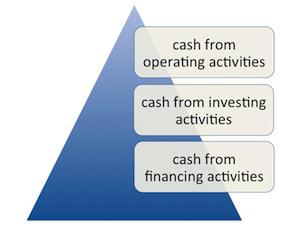Think like your accountant
When you look at a complicated cash flow statement in an annual report, it might look like accountants do anything but make it simple. Yet if you want to take some fast action when cash is tight, the basic structure of a cash flow statement makes a very handy checklist.
It’s made up of three very simple categories. Cash is either raised or spent in:
- operating activities
- investing activities
- financing activities
In plain English, those three things mean what you do, what you’ve got and how you fund the first two. That’s pretty much all there is to cash flow. It’s not exactly rocket science.

For a simple health check, what can you do about each cash flow category?
Operating activities: what you do
First of all you spend money to buy things to make things. That means you have payables. Can you pay for them later? Can you pay less for them? Try talking to your suppliers about your terms and conditions.
Second, you sell those things for money. That’s receivables. Can you send your invoices sooner? Can you reduce the time lag to payment with an earlier due date? The closer you go to matching the timing of payables with receivables, the less capital you need and the more cash you have available.
Third, how much inventory are you holding. Stock ties up capital. Can you run a leaner business, ordering stock only when it’s needed? Even accountants keep this simple. They call it Just-In-Time inventory management.
Investing activities: what you’ve got
Do you need all the assets you’ve invested in? If your delivery van were under-utilized, would it be better to sell it and outsource to a delivery service? Or has your business moved on, leaving capital invested in under-used or idle assets that you can sell.
There is a strong case for the business equivalent of garage sale. When it comes to raising cash, strategies such as outsourcing, or selling your premises and leasing them back can make a lot of sense. Try to de-clutter your asset base.
How you fund the first two
If you are funding your business with borrowings, including your overdraft, are you borrowing at the best rate? Can you slow down, or speed up, your repayment schedule? If you pay a dividend, can you vary them or shift the intervals at which you pay them? What about a dividend reinvestment program? You don’t need to be a listed company to issue shares. Can you borrow more cheaply from your shareholders, or yourself?
Cash flow strategy is not a static policy. Conditions in all three areas constantly shift. Make a habit of checking your performance in all three. Tightly managed cash flow reduces your overall cost of capital. It’s the cheapest way to boost your returns and grow the value of your business.
For a tip sheet on more things you can do, got to Recharge Workshop and download the module called "Fundamentals of cash flow management".

